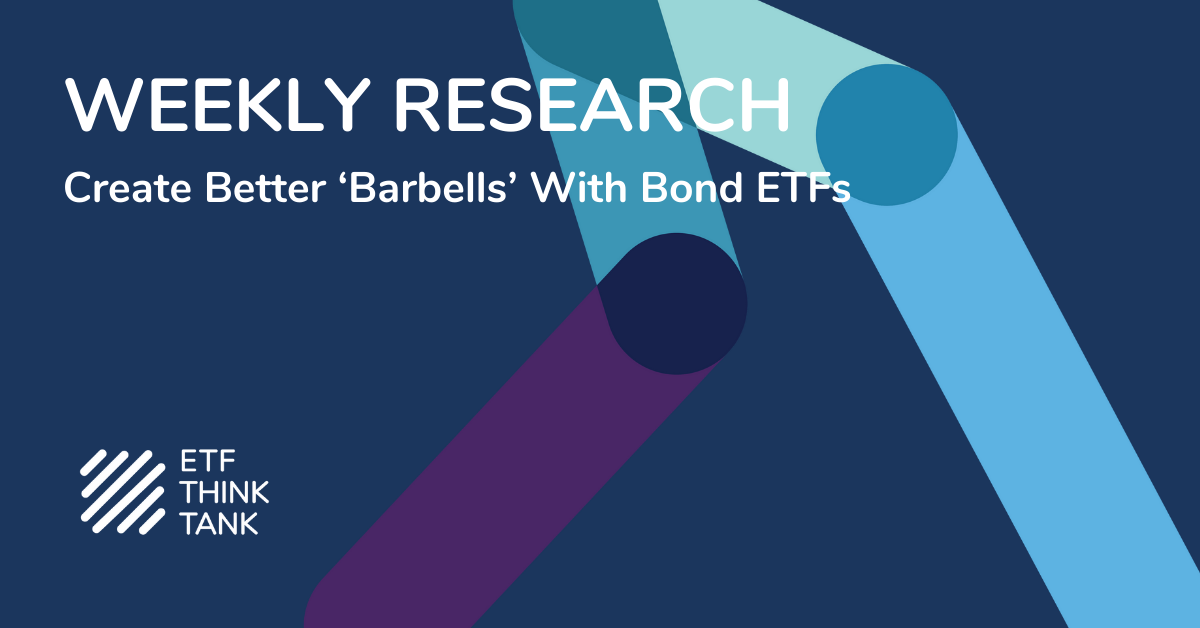Many investors expect the return streams from bond ETFs to behave like the direct purchase of a bond, essentially providing current income with the likely return of principle at a future date. Although the expansion of ETFs has provided investors access to bonds, and at a reasonable cost, the performance behavior of these ETFs are often very different from the direct purchase of individual bonds.
The top five* bond ETFs by assets include:

These ETFs represent about $104 billion in assets and have an average current yield of 3.37 percent and an average duration of 5.11 years. So, like a direct purchase in a bond investors can expect that a 100 bps rise in interest rates may likely cause a 5 percent reduction in principal, wiping out over a year and a half of the average income.
The major difference between the ETF structure and the direct purchase is that the ETF investor may never recover the 5 percent principal at maturity because the index does not mature.
The lineup of BulletShares target date maturity bond ETFs from Guggenheim has tried to provide a solution to this conundrum, but they are still subject to the second inefficiency. The future income distribution of the ETF is not locked in at purchase at the current yield; the yield changes as the constituents of the index change.
Toroso’s conclusion is that some of the traditional metrics of evaluating bonds, like current yield and average maturity, are inadequate relative to the ETF structure. That said, we have devised a methodology for income ETF security selection that we believe is more consistent with the behavior of bond ETFs. Additionally, Toroso uses an asset-allocation methodology for bond ETFs that behaves more like a direct purchase of a bond.
Security Selection
With the threat of rising interest rates looming, how can investors evaluate the risk associated with bond ETFs if metrics like maturity and coupon do not apply to the ETF structure? We believe this all boils down to maximizing income, with the minimal amount of volatility possible. To assist in this, we use a methodology we call the Risk Adjusted Excess Income Ratio (RAEI). We take the principals of the Sharpe Ratio, and seek out excess output above a risk-free rate per unit of volatility but, instead of return, we focus on income. The formula is below:

The formula allows us to evaluate the excess yield per unit of volatility. Positive ratio outputs, relative to similar investments, are indicative of an attractive investment. This combined with other efficient metrics, like duration; assist us in choosing optimal bond ETFs.
In a table on page 2 of this Commentary, we analyzed the five largest bond ETFs, as well as two securities used within Toroso’s strategies, and used the 12-month yield of the iShares 1-3 Year Treasury Bond ETF (SHY) as our risk-free yield (0.42%). But first, let’s discuss the Barbell Allocation Technique.
Asset Allocation
One of the techniques Toroso uses to address the inefficiencies of bond ETFs is to build an “Income Barbell Portfolio.”
One example of this approach combines equal weightings of cash-like ETFs like the Guggenheim Enhanced Short Duration Bond ETF (GSY) and income-oriented ETFs such as the PowerShares CEF Income Composite Portfolio (PCEF). Using the two, we can synthetically construct a potentially higher-yielding and less-volatile portfolio than investors can find with traditional bond ETFs. As shown in the table, both ETFs score favorably on the RAEI Ratio. And, further, their combination creates a attractive yield of 4.67 percent with duration of 1.57 years, and a RAEI Ratio of 1.25.

Beyond the Traditional Barbell
Historically, when pursuing a bond barbell strategy, investors purchase short-term and long-term bonds only. Theoretically, this provides the best of both worlds. At the high end of the barbell, you lock in higher rates. On the short end of the barbell, investors have less interest rate and credit risk. And when short-term bonds mature, investors use their proceeds to reinvest.
An “Income Barbell Portfolio” expands the potential universe of income-oriented investments. Toroso constructs the risk end of the income barbell by combining ETFs consisting of bonds, closed-end funds, preferred stocks, dividend producing common stocks, REITs and income-oriented MLPs.
Meanwhile the safety component, which consists of cash equivalent ETFs, seeks to reduce volatility and provide a compounding base to protect principal.
By selecting bond ETFs by evaluating their excess yield adjusted for their past volatility combined with an barbell allocation, Toroso believes that an ETF portfolio can produce results similar to a direct investment in a bond.
In the Appendix is the risk adjusted excess income calculation for the 10 largest bond ETFs, cash like ETFs, and dividend equity ETFs, as well as the top 10 alternative ETFs: all ranked by highest RAEI. The first 3 categories were generated based on overall AUM as all 3 categories focus on generating income.



Disclosure
All investments involve risk, including possible loss of principal.
This material is provided for informational purposes only and should not be considered an individualized recommendation or personalized investment advice. The investment strategies mentioned may not be suitable for everyone. Each investor needs to review an investment strategy for his or her own particular situation before making any investment decision.
All expressions of opinion are subject to change without notice in reaction to shifting market conditions. Data contained herein from third party providers is obtained from what are considered reliable sources. However, its accuracy, completeness or reliability cannot be guaranteed.
Examples provided are for illustrative purposes only and not intended to be reflective of results you can expect to achieve.
The value of investments and the income from them can go down as well as up and investors may not get back the amounts originally invested, and can be affected by changes in interest rates, in exchange rates, general market conditions, political, social and economic developments and other variable factors. Investment involves risks including but not limited to, possible delays in payments and loss of income or capital. Neither Toroso nor any of its affiliates guarantees any rate of return or the return of capital invested. This commentary material is available for informational purposes only and nothing herein constitutes an offer to sell or a solicitation of an offer to buy any security and nothing herein should be construed as such. All investment strategies and investments involve risk of loss, including the possible loss of all amounts invested, and nothing herein should be construed as a guarantee of any specific outcome or profit. While we have gathered the information presented herein from sources that we believe to be reliable, we cannot guarantee the accuracy or completeness of the information presented and the information presented should not be relied upon as such. Any opinions expressed herein are our opinions and are current only as of the date of distribution, and are subject to change without notice. We disclaim any obligation to provide revised opinions in the event of changed circumstances.
The information in this material is confidential and proprietary and may not be used other than by the intended user. Neither Toroso or its affiliates or any of their officers or employees of Toroso accepts any liability whatsoever for any loss arising from any use of this material or its contents. This material may not be reproduced, distributed or published without prior written permission from Toroso. Distribution of this material may be restricted in certain jurisdictions. Any persons coming into possession of this material should seek advice for details of and observe such restrictions (if any).












